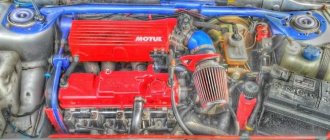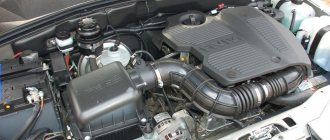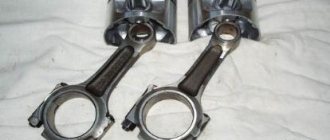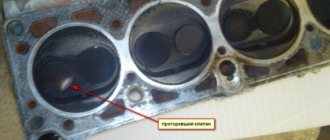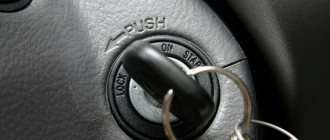Electric motor power calculation
Calculation of electric motor power by current can be done using our online calculator:
The result obtained can be rounded to the nearest standard power value.
Standard values of electric motor power : 0.25; 0.37; 0.55; 0.75; 1.1; 1.5; 2.2; 3.0; 4.0; 5.5; 7.5; eleven; 15; 18.5; 22; thirty; 37; 45; 55; 75 kW, etc.
Engine power is calculated using the following formula:
P=√3UIcosφη
- U - Rated voltage (voltage to which the electric motor is connected);
- I - Rated current of the electric motor (taken from the passport data of the electric motor , and in their absence is determined by calculation);
- cosφ - Power factor - the ratio of active power to total power (taken from 0.75 to 0.9 depending on the power of the electric motor);
- η - Efficiency factor - the ratio of the electrical power consumed by the electric motor from the network to the mechanical power on the motor shaft (taken from 0.7 to 0.85 depending on the power of the electric motor);
How to determine the power of an electric motor with and without a tag - an overview of techniques
In practice, it is not always necessary to work with electric motors whose operating parameters are known. This information is usually indicated on the tag, but it may be erased or missing altogether. What to do in such a situation, do not throw out the “engine”? In this article we will tell you how to determine the power of an electric motor by overall dimensions, current and other indicators. Let’s make a reservation that the article will mainly focus on three-phase asynchronous electric motors, since they are the most common.
Motor current calculation
The rated and starting current of an electric motor can be calculated by power using our online calculator:
The rated motor current is calculated using the following formula:
Inom=P/√3Ucosφη
- P - Rated power of the electric motor (taken from the motor’s passport data or determined by calculation);
- U - Rated voltage (voltage to which the electric motor is connected);
- cosφ - Power factor - the ratio of active power to total power (taken from 0.75 to 0.9 depending on the power of the electric motor);
- η - Efficiency factor - the ratio of the electrical power consumed by the electric motor from the network to the mechanical power on the motor shaft (taken from 0.7 to 0.85 depending on the power of the electric motor);
The starting current of the electric motor is calculated using the formula:
Istart=Inom* K
- K - Starting current multiplicity, this value is taken from the electric motor passport, or from catalog data (in the above online calculator, the starting current multiplicity is determined approximately based on the other specified characteristics of the electric motor).
Method for determining electric motor power
There are various calculation formulas that allow you to determine the exact power of an electric motor. To use some formulas, the user will have to measure the dimensions of the motor stator; for other formulas, the user needs to know the current value or the efficiency of the motor. Many experts use these formulas in practice, but there is also a much simpler, more convenient method for determining engine power - practical measurements. Using an installed meter for electrical energy consumption in a household electrical network, you can find out the power of any equipment.
To carry out such measurements, it will be necessary to disconnect all household electrical devices from the power supply so that not a single device consumes electrical energy and the meter does not spin. Lighting must also be turned off, since even one light bulb on can harm the tests.
Features of determining power depend on what kind of electricity consumption meter you have installed. If a Mercury meter is installed at the electricity input to the facility, it is enough to simply turn on the electric motor at full power for 3-5 minutes. While the engine is running, the meter will show the load value, measured in kW.
Such measurements can be carried out using a standard induction consumption meter, but you need to remember that such devices keep records in kW/h. So, first you need to write down the exact meter readings before starting the study, then you need to turn on the engine for exactly 10 minutes, without allowing any errors. It is best to keep track of time using a stopwatch, which allows you to turn the engine on and off in time. After turning off the engine, you need to take readings from the induction meter and subtract the value recorded before the measurements from the readings. Now we multiply the indicators by 6. The results obtained from these simple measurements and calculations will accurately reflect the active power of the engine in kW.
It is more difficult to determine the technical characteristics of low-power engines, but their power can also be calculated, although this will require more effort. The easiest way to determine engine power is by counting the full revolutions of the disk per unit of time. For example, the meter indicates that 1200 revolutions equals 1 kW/h. If the counter makes 10 revolutions within one minute, then in this case 10 must be multiplied by 60 (the number of minutes in an hour) and we get 600 revolutions per hour. Divide 1200 by 600 and get the power of the electric motor
It is important to note that the accuracy is directly affected by the duration of the measurements. The longer you take the readings, the more accurately you can determine engine power.
Calculation of electric motor power factor
Online calculation of power factor (cosφ) of an electric motor
Calculation of cosφ (cosine phi) of the engine is carried out using the following formula:
cosφ=P/√3UIη
- P - Rated power of the electric motor (taken from the motor’s passport data or determined by calculation);
- U - Rated voltage (voltage to which the electric motor is connected);
- I - Rated current of the electric motor (taken from the passport data of the electric motor , and in their absence is determined by calculation);
- η - Efficiency factor - the ratio of the electrical power consumed by the electric motor from the network to the mechanical power on the motor shaft (taken from 0.7 to 0.85 depending on the power of the electric motor);
First we look at the tag
The simplest way is to determine engine power using a nameplate (also called a plate or tag). First of all, it is worth remembering that the number indicated on the tag is the mechanical power on the shaft, the so-called. P2. To find the active electrical P1 (which your meter will take into account), you need to divide it by the efficiency (η), and to find the total S, you also need to divide it by COSф, you will find them on the same nameplate.
P1 = P2/η = 180/0.68 = 265 (W)
S = P1/cosФ = 265/0.78 = 340 (W)
And if only the current is indicated, you can determine the total power using the standard formula for three-phase circuits:
If, according to the example of the nameplate above, then:
S = 380*0.52*1.73 = 341 (VA)
P1 = S*cosФ = 341*0.78 = 266 (W)
And mechanical P2 on the shaft:
As you can see, the results of calculations for current and voltage coincided with the numbers indicated on the plate. From the nameplate you can determine other parameters of the electric motor, such as rated voltage, current, and rpm.
Calculation of electric motor efficiency
Online calculation of efficiency (efficiency) of an electric motor
The efficiency of the electric motor is calculated using the following formula:
η=P/√3UIcosφ
- P - Rated power of the electric motor (taken from the motor’s passport data or determined by calculation);
- U - Rated voltage (voltage to which the electric motor is connected);
- I - Rated current of the electric motor (taken from the passport data of the electric motor , and in their absence is determined by calculation);
- cosφ - Power factor - the ratio of active power to total power (taken from 0.75 to 0.9 depending on the power of the electric motor);
Did you find these online calculators useful? Or maybe you still have questions ? Write to us in the comments!
Didn’t find an article on the website on a topic that interests you regarding electrical engineering? Write to us here. We will definitely answer you.
Source
Calculation of current strength by power, voltage, resistance
Free calculator for calculating current strength by power and voltage/resistance - calculate the current strength in a single-phase or three-phase network in ONE CLICK!
If you want to learn how to calculate the current in a circuit by power, voltage or resistance, we suggest using this online calculator. The program performs calculations for DC and AC networks (single-phase 220 V, three-phase 380 V) according to Ohm's law. We recommend not to change the power factor value (cos φ) unless necessary and leave it at 0.95. Knowing the magnitude of the current allows you to select the optimal material and diameter of the cable, install reliable fuses and circuit breakers that can protect the apartment from possible overloads. Click on the button to get the result.
Determination of power by current consumption
The power of a motor can be determined by the current it consumes. To measure the current we will use a current clamp. Before starting measurements, first turn off the voltage supply to the electric motor. After this, remove the cover from the terminal box and straighten the conductive wires to ensure easy access to them. Then we apply voltage to the engine and let it run at rated load for several minutes. We set the measurement limit to the value “200 A” and use a current clamp to measure the current consumed in one of the phases. Next, we measure the voltage on the windings using the probes included in the set of current clamps. We set the wheel for selecting modes and measurement limits to the position for measuring alternating voltage with a limit of 750 V. We attach the red probe to the socket for measuring voltage, resistance and current up to ten Amps, and the black one to the “COM” socket. Measurements are taken between terminals “U1-V1” or “V1-W1” or “U1-W1”. We calculate the power of the electric motor using the formula: S=1.73×I×U, where S is the total power (kVA), I is the current (A), U is the value of the line voltage (kV). We measure the current in one of the phases, as well as the voltage and substitute the obtained values into the formula (for example, when measuring, we received a current equal to 15.2A and a voltage of 220V): S = 1.73 × 15.2 × 0.22 = 5.78 kVA It is important to note that the power email motor does not depend on the connection diagram of the stator windings. This can be verified by taking measurements on the same motor, but with stator windings connected in a star configuration: the measured current will be 8.8A, voltage 380V. We also substitute the values into the formula: S=1.73×8.8×0.38=5.78 kVA Using this formula, we determined the electric motor power consumed from the electrical network. To find out the engine power on the shaft, you need to multiply the resulting value by the engine power factor and its efficiency. Thus, the formula for engine power looks like this: P=S×сosφ×(η÷100), where P is the engine power on the shaft; S – total engine power; сosφ – power factor of an asynchronous electric motor; η – engine efficiency. Since we do not have accurate data, we will substitute the average values of cosφ and engine efficiency into the formula: P=5.78×0.8×0.85=3.93≈4kW Thus, we have determined the power of the electric motor, which is equal to 4 kW. We talked about the most reliable methods for determining the power of an electric motor. You can also watch our video, which shows in detail how to determine the power of an electric motor.
Formulas for calculating current strength
Electric current is the directed, ordered movement of charged particles. Current strength (I) is the amount of current passed per unit time through the cross section of the conductor. The international unit of measurement is Ampere (A/A).
— Current through power and voltage (direct current): I = P / U — Current through power and voltage (single-phase alternating current): I = P / (U × cosφ) — Current through power and voltage (three-phase alternating current) ): I = P / (U × cosφ × √3) - Current through power and resistance: I = √(P / R) - Current through voltage and resistance: I = U / R
- P – power, W;
- U – voltage, V;
- R – resistance, Ohm;
- cos φ – power factor.
Power factor cos φ is a relative scalar value that characterizes how efficiently electrical energy is used. For household appliances, this coefficient is almost always in the range from 0.90 to 1.00.
Source
How to determine power?
There are several ways to determine the power of an electric motor: by shaft diameter, by size and length, by current and resistance, by measuring with an electricity meter.
By overall dimensions
All electric motors differ in overall dimensions. You can determine the engine power by comparing the overall dimensions with the table for determining the power of the electric motor by clicking on the link overall and connecting dimensions of AIR electric motors.
What dimensions need to be measured:
- Length, width, height of the case
- Distance from center of shaft to floor
- Shaft length and diameter
- Mounting dimensions for feet (flange)
By shaft diameter
Determining the power of an electric motor by shaft diameter is a common request for search engines. But this parameter is not enough to accurately determine - two engines of the same size, with the same shafts and rotation speed can have different power.
A table relating shaft diameters to power and speed for AIR and 4AM engines.
| Electric motor power P, kW | Shaft diameter, mm | Go to model | |||
| 3000 rpm | 1500 rpm | 1000 rpm | 750 rpm | ||
| 0,18 | 11 | 11 | 14 | — | AIR56A2, AIR56V4, AIR63A6 |
| 0,25 | 14 | 19 | AIR56V2, AIR63A4, AIR63V6, AIR71V8 | ||
| 0,37 | 14 | 19 | 22 | AIR63A2, AIR63V4, AIR71A6, AIR80A8 | |
| 0,55 | 19 | AIR63V2, AIR71A4, AIR71V6, AIR80V8 | |||
| 0,75 | 19 | 22 | 24 | AIR71A2, AIR71B4, AIR80A6, AIR90LA8 | |
| 1,1 | 22 | AIR71V2, AIR80A4, AIR80V6, AIR90LB8 | |||
| 1,5 | 22 | 24 | 28 | AIR80A2, AIR80B4, AIR90L6, AIR100L8 | |
| 2,2 | 24 | 28 | 32 | AIR80V2, AIR90L4, AIR100L6, AIR112MA8 | |
| 3 | 24 | 32 | AIR90L2, AIR100S4, AIR112MA6, AIR112MV8 | ||
| 4 | 28 | 28 | 38 | AIR100S2, AIR100L4, AIR112MV6, AIR132S8 | |
| 5,5 | 32 | 38 | AIR100L2, AIR112M4, AIR132S6, AIR132M8 | ||
| 7,5 | 32 | 38 | 48 | AIR112M2, AIR132S4, AIR132M6, AIR160S8 | |
| 11 | 38 | 48 | AIR132M2, AIR132M4, AIR160S6, AIR160M8 | ||
| 15 | 42 | 48 | 55 | AIR160S2, AIR160S4, AIR160M6, AIR180M8 | |
| 18,5 | 55 | 60 | AIR160M2, AIR160M4, AIR180M6, AIR200M8 | ||
| 22 | 48 | 55 | 60 | AIR180S2, AIR180S4, AIR200M6, AIR200L8 | |
| 30 | 65 | AIR180M2, AIR180M4, AIR200L6, AIR225M8 | |||
| 37 | 55 | 60 | 65 | 75 | AIR200M2, AIR200M4, AIR225M6, AIR250S8 |
| 45 | 75 | 75 | AIR200L2, AIR200L4, AIR250S6, AIR250M8 | ||
| 55 | 65 | 80 | AIR225M2, AIR225M4, AIR250M6, AIR280S8 | ||
| 75 | 65 | 75 | 80 | AIR250S2, AIR250S4, AIR280S6, AIR280M8 | |
| 90 | 90 | AIR250M2, AIR250M4, AIR280M6, AIR315S8 | |||
| 110 | 70 | 80 | 90 | AIR280S2, AIR280S4, AIR315S6, AIR315M8 | |
| 132 | 100 | AIR280M2, AIR280M4, AIR315M6, AIR355S8 | |||
| 160 | 75 | 90 | 100 | AIR315S2, AIR315S4, AIR355S6 | |
| 200 | AIR315M2, AIR315M4, AIR355M6 | ||||
| 250 | 85 | 100 | AIR355S2, AIR355S4 | ||
| 315 | — | AIR355M2, AIR355M4 | |||
According to the meter reading
Typically, meter measurements are displayed in kilowatts (hereinafter referred to as kW). For accurate measurements, you should turn off all electrical appliances or use a portable meter. The power of the electric motor is 2.2 kW, which means that it consumes 2.2 kW of electricity per hour.
To measure power using a meter reading you need:
- Connect the motor and let it run for 6 minutes.
- Multiply the meter measurements by 10 - we get the exact power of the electric motor.
Calculation of power by current
First you need to connect the motor to the network and measure the voltage readings. We measure the current consumption on each of the phase windings using an ammeter or multimeter. Next, we find the sum of the currents of the three phases and multiply them by the previously measured voltage indicators, clearly in the formula for calculating the power of the electric motor by current.
- P – electric motor power;
- U – voltage;
- Ia – 1st phase current;
- Ib – 2 phases;
- Ic – 3 phases.
Current to power conversion calculator
To calculate the load on the electrical network and energy costs, you can use a special calculator for converting current to power. This function appeared recently, greatly facilitating manual determination.
Although the formulas have been known for a long time, not everyone knows physics well enough to independently determine the current strength in the network. The calculator helps with this, since it is enough to know the voltage and power to work.
- What is power Watt [W]
- What is Current Strength. Ampere [A]
- How many watts are in 1 ampere?
- Ampere – Watt conversion table
- Why do you need a calculator?
- How to use
Motor power
Electrical power is a physical quantity that is characterized by the rate of transformation or transmission of electrical energy. To make it easier to understand, electricians imagine the movement of current as the movement of liquid through a pipe, and voltage as the difference in the position of the tiers of this liquid. Electricity, while carrying out work, moves from high to low power, just like liquid. This means that electrical power is the amount of work that is done in 1 second, or the speed at which the work itself is performed. The sum of the electric current that passes through the cross section of the circuit for one second is the current strength in the circuit itself.
It follows that electrical power is equal in proportion to the voltage and current in the circuit. To determine the current power, the unit used is the watt, abbreviated as W. For physical calculations, it was customary to use the standard formula N=A/t, where N is power, A is work, t is time. There are many variations of this formula with different letter symbols.
What is power Watt [W]
Power is a quantity that determines the ratio of work performed by a current source over a certain period of time. One watt corresponds to the product of one ampere and one volt, but when determining energy costs, the value of kilowatt/hour .
It corresponds to the consumption of one thousand watts for 60 minutes of operation. It is by this indicator that the cost of electricity services is determined.
In most cases, the power consumed by the device is indicated in the technical documentation or on the packaging. The specified quantity is produced in one hour of work.
For example, a computer with a 500 W power supply will spin 1 kW for 2 hours of operation.
To help determine the current strength at a known power, a calculator will help, which converts one physical quantity to another.
What is Current Strength. Ampere [A]
Current is the speed at which electrical charge flows through a conductor. One ampere is equal to a charge of one coulomb that passes through a conductor in one second. One coulomb represents a very large charge, so in most devices this value is measured in milliamps.
The current strength depends on the cross-section of the conductor and its length. This must be taken into account when planning structures, as well as choosing electrical appliances. Although most should not think about this, since this is the task of engineers and designers.
How many watts are in 1 ampere?
To determine the power of a circuit, the concept of voltage is also important. This is the electromotive force that moves electrons. It is measured in volts. Most devices have this characteristic in their documentation.
Ampere – Watt conversion table
To convert watts to amperes, you need to use the previous formula, expanding it. To calculate the current, you need to divide the power by the voltage: I = P/U. The following table shows the amperage for devices with different voltages - 6, 12, 24, 220 and 380 volts.
Remember that for high voltage networks, the specified amperage differs depending on the efficiency.
Table of the ratio of amperes and watts, depending on voltage.
| 6V | 12V | 24V | 220V | 380V | |
| 5 W | 0.83A | 0.42A | 0.21A | 0.02A | 0.008A |
| 6 W | 1.00A | 0.5A | 0.25A | 0.03A | 0.009A |
| 7 W | 1.17A | 0.58A | 0.29A | 0.03A | 0.01A |
| 8 W | 1.33A | 0.66A | 0.33A | 0.04A | 0.01A |
| 9 W | 1.5A | 0.75A | 0.38A | 0.04A | 0.01A |
| 10 W | 1.66A | 0.84A | 0.42A | 0.05A | 0.015A |
| 20 W | 3.34A | 1.68A | 0.83A | 0.09A | 0.03A |
| 30 W | 5.00A | 2.5A | 1.25A | 0.14A | 0.045A |
| 40 W | 6.67A | 3.33A | 1.67A | 0.13A | 0.06A |
| 50 W | 8.33A | 4.17A | 2.03A | 0.23A | 0.076A |
| 60 W | 10.00A | 5.00A | 2.50A | 0.27A | 0.09A |
| 70 W | 11.67A | 5.83A | 2.92A | 0.32A | 0.1A |
| 80 W | 13.33A | 6.67A | 3.33A | 0.36A | 0.12A |
| 90 W | 15.00A | 7.50A | 3.75A | 0.41A | 0.14A |
| 100 W | 16.67A | 3.33A | 4.17A | 0.45A | 0.15A |
| 200 W | 33.33A | 16.66A | 8.33A | 0.91A | 0.3A |
| 300 W | 50.00A | 25.00A | 12.50A | 1.36A | 0.46A |
| 400 W | 66.66A | 33.33A | 16.7A | 1.82A | 0.6A |
| 500 W | 83.34A | 41.67A | 20.83A | 2.27A | 0.76A |
| 600 W | 100.00A | 50.00A | 25.00A | 2.73A | 0.91A |
| 700 W | 116.67A | 58.34A | 29.17A | 3.18A | 1.06A |
| 800 W | 133.33A | 66.68A | 33.33A | 3.64A | 1.22A |
| 900 W | 150.00A | 75.00A | 37.50A | 4.09A | 1.37A |
| 1000 W | 166.67A | 83.33A | 41.67A | 4.55A | 1.52A |
Using the table it is also easy to determine the power if the voltage and current are known. This is useful not only for calculating energy consumption, but also for choosing special equipment responsible for uninterrupted operation or preventing overheating.
What is needed to calculate power?
To calculate the horsepower of a car, you must first of all have a car and a service station. To carry out this procedure, it is recommended to use the Russian measurement system, since with European systems some inconsistencies may arise during the calculation. For them, it is customary to equate 1 horsepower to 75 kgm/s. In other words:
1 hp =75 kgm/s
where 75 is the power of lifting a load weighing at a height of 1 m in 1 second.
In addition, power in horsepower can be converted into another dimensional unit, kilowatt. It looks like this:
1 hp = 735.5 W (0.735 kW)
Moreover, in this case, the maximum speed developed by the car will be called boiler horsepower.




